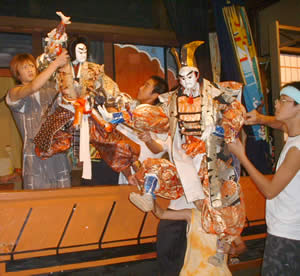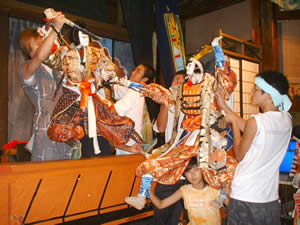|
MONTHLY NEWS Children Keep Alive Traditional Puppetry | ||||||||
On the evenings of September 15 and 16, elementary and middle school students led performances of Anori Bunraku, a style of Japanese puppet theater that has a history of over 400 years and has been designated as an important national cultural treasure. Although they are children, the students are all accomplished puppeteers. Every year on these dates, the traditional art is performed at Anori Shrine in Ago, Mie Prefecture, during the shrine's annual festival. Ago is a town located at the tip of Shima Peninsula, 80 kilometers south of Nagoya. Bunraku is a type of puppet theater in which a story is told with puppets and joruri - narrative singing accompanied by shamisen (a Japanese stringed instrument). Bunraku became popular in the Edo period (1603-1868) and is known today as one of Japan's three national theatrical arts, together with noh and kabuki. Bunraku puppets are quite different from marionettes or hand puppets. First, it takes three people to move a single puppet: one for the head and right arm, one for the left arm, and one for the legs. Also, the puppeteers are fully visible to the audience. But this doesn't distract the spectators, who are concentrated on the story and on the movements of the puppets. Performances of Anori Bunraku stopped during World War II, but people who wanted to keep the tradition alive with their own hands formed a preservation society in 1951. At the center of the society's activities are the members of the youth division: 3 elementary school students, 12 middle school students, and 5 high school students. These young people are actively involved in keeping the local art of puppet theater alive. The bunraku club of Anori Middle School also plays an important role in continuing the tradition. Bunraku is a part of life in this town, and of the school's 66 students, 34 are members of the club. Sakashita Haruka, who is in third grade in this school, says, "I've thought Anori Bunraku is awesome ever since I was little. I knew I'd be able to do it in middle school, so I joined the club as soon as I entered the school."
Bunraku puppets are about 1.0 meter to 1.2 meters tall and can weigh as much as 25 kilograms. Even among adults, beginners can't perform for more than a minute or two, so practicing is extra hard work for the children. Preparations for the September performances start in April, when the school year begins, and from July onward the kids rehearse with the real puppets. The young puppeteers dedicate much of their summer vacation to rehearsals. "It was tough attending all the rehearsals during summer break, because there were so many of them," says Morishita Yumi. "But I kept myself going by thinking, 'I'm only in the second year, and I have to do this next year too, so I can't get lazy now.'" And how did the performances go? Third-year student Asai Taishi, who performed for the third time and controlled the head of the principal male puppet this year, seems satisfied. "In my first year, my knees were shaky and I couldn't concentrate on the performance. But since I've been doing it for three years now, I was able to control the puppet well. I'm happy I was able to perform with confidence." Over the two days, the spirited performances of Anori Bunraku by the kids drew about 2,300 spectators. NOTICE: Since October 9, 2003, Japanese names in Kids Web Japan have been written in their original order: surname first. |
 |

